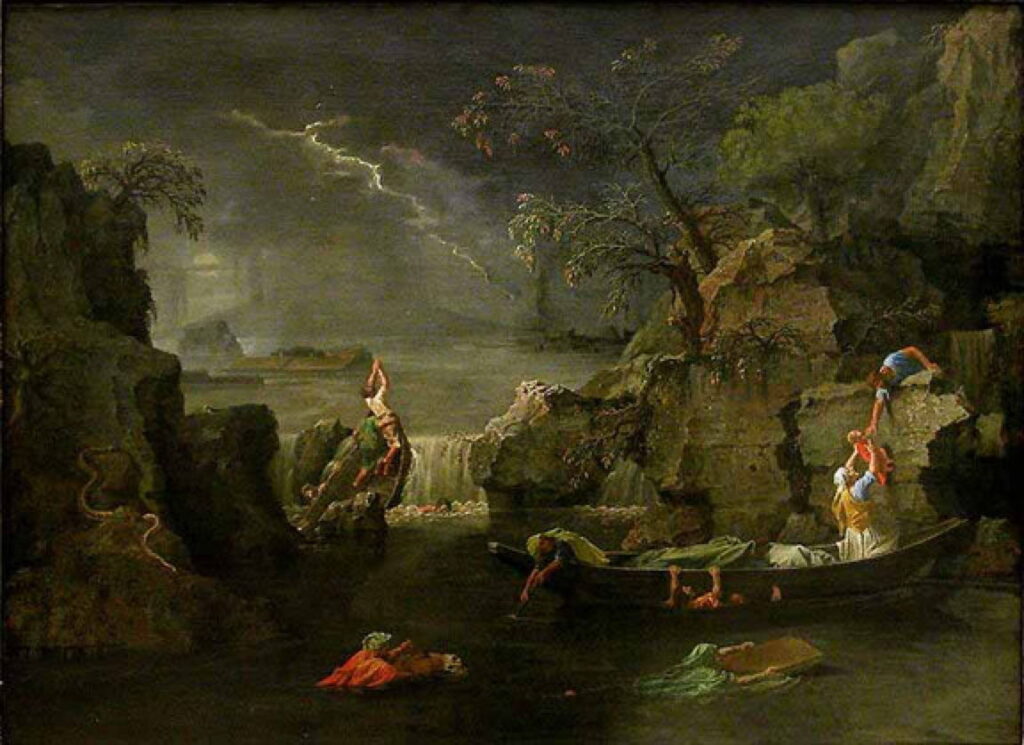Reading Visual Art: 189 Lightning of the gods

If there’s one thing sure to put the fear of God into someone it’s a nearby bolt of lightning. One of the most understandable associations of lightning is thus with deities, particularly those who are as swift to anger and avenge as a sudden thunderstorm. In the myths of classical Greece and Rome, that could only mean Zeus or Jupiter, whose bundle of thunderbolts has even survived into computer technology.
Jan Cossiers (1600–1671), Jupiter and Lycaon (c 1640), oil on canvas, 120 × 115 cm, Museo Nacional del Prado, Madrid. Wikimedia Commons.
Jan Cossiers’ impressive Jupiter and Lycaon from about 1640 shows Jupiter’s eagle vomiting thunderbolts at Lycaon, who is hurrying away as he is being transformed into a wolf, becoming the prototype for the werewolf of the future. These thunderbolts resemble arrows with shafts that zigzag like lightning in the sky, and are preserved today in the symbol used for Thunderbolt.
Tintoretto (Jacopo Comin) (attr) (1518–1594), Jupiter and Semele (1545), oil on spruce wood, 22.7 × 65.4 cm, National Gallery (Bought, 1896), London. Photo © The National Gallery, London.
Tintoretto’s Jupiter and Semele (1545) shows an early moment in the myth of the mortal woman who was raped by the god, then destroyed by his thunderbolts when in late pregnancy. She reclines naked under a red tent. Jupiter has evidently just revealed himself, and rolls of cloud are rushing out from him. There are thunderbolt flames licking at Semele’s tent, and around the clouds surrounding Jupiter, but no sign of them touching Semele yet.
The myth of Philemon and Baucis also revolves around Jupiter visiting mortals, this time in innocuous human form and in company with Mercury. After the elderly couple have entertained the two gods, they go outside and ascend a mountain while the land below becomes flooded.
Peter Paul Rubens (1577–1640), Stormy Landscape with Philemon and Baucis (c 1625?), oil on oak, 146 × 208.5 cm, Kunsthistorisches Museum, Vienna. Wikimedia Commons.
Peter Paul Rubens’ Stormy Landscape with Philemon and Baucis (c 1625?) is a dramatic landscape with storm-clouds building over the hills, bolts of lightning, a raging torrent pouring down the mountainside, and the four figures on a track at the right. Philemon and Baucis are struggling up the track with their sticks, as they’re being taken to safety from the rising flood by Jupiter and Mercury.
Richard Wilson (1714–1782), The Destruction of Niobe’s Children (1760), oil on canvas, 166.4 x 210.8 cm, Yale Center for British Art, New Haven, CT. Wikimedia Commons.
Richard Wilson’s Destruction of Niobe’s Children from 1760 is a classical history-in-landscape, with a bolt of lightning in the centre far distance, a chiaroscuro sky, and rough sea below. Wilson shows this myth when Apollo is still killing Niobe’s sons. The god is at the top of a steep bank on the left, with Niobe among her children down below.
Nicolas Poussin (1594–1665), Landscape during a Thunderstorm with Pyramus and Thisbe (1651), oil on canvas, 274 × 191 cm, Städelsches Kunstinstitut und Städtische Galerie, Frankfurt, Germany. Wikimedia Commons.
Nicolas Poussin’s setting of a Landscape during a Thunderstorm with Pyramus and Thisbe (1651) shows the city of Babylon in the distance, along a picturesque and pastoral valley. But the peacefulness of this landscape has been transformed by the sudden arrival of a thunderstorm: the gusty wind is already bending the trees, and near the centre of the view a large branch has broken with its force. Two bolts of lightning make their way to the hills below.
There’s frantic activity in response not only to the storm, but to a lioness attacking a horse, whose rider has fallen. An adjacent horseman is about to thrust his spear into the back of the lioness, while another, further ahead, is driving cattle away from the scene. Others on foot, and a fourth horseman, are scurrying away, driven by the combination of the lioness and the imminent storm.
In the foreground, Pyramus lies dying, his sword at his side, and his blood flowing freely on the ground, down to a small pond. Thisbe has just emerged from sheltering in the cave, has run past the bloodied shawl at the right, and is about to reach the body of her lover. She is clearly distraught.
John Martin (1789–1854), The Destruction of Tyre (1840), oil on canvas, 83.8 x 109.5 cm, Toledo Museum of Art, Toledo, OH. Wikimedia Commons.
The apocalyptic British painter John Martin told the semi-historical story of The Destruction of Tyre in this relatively small painting of 1840. Tyre was the great Phoenician port on the Mediterranean coast, claimed to have been the origin of navigation and sea trade. The prophet Ezekiel (chapter 26) foretold that one day, many nations would come against Tyre, would put the city under siege, break her walls down, that the fabric of the city would be cast into the sea, and it would never be rebuilt. Martin brings the forces of nature in to help destroy the port, with a storm great enough to sink many vessels, leaving their prows floating like sea monsters. In the distance is his standard lightning bolt.
Nicolas Poussin (1594–1665), Winter or Flood (c 1660-64), oil on canvas, 118 x 160 cm, Musée du Louvre, Paris. Wikimedia Commons.
Poussin used the great flood in Genesis as the underlying narrative in his late painting of Winter (c 1660-64), from his series of the four seasons. Lightning crackles through the sky as a few survivors try to escape the rising waters.
Mårten Eskil Winge (1825–1896), Thor’s Fight with the Giants (1872), oil on canvas, 26 x 32.7 cm, Nationalmuseum, Stockholm, Sweden. Wikimedia Commons.
In Norse mythology it’s the god Thor who wields the thunderbolts. Mårten Eskil Winge’s painting of Thor’s Fight with the Giants (1872) shows this lesser-known battle in rich detail, including the two goats drawing the god’s chariot, and lightning bolts playing around his mighty hammer, the cause of thunder.
Alexander Dmitrievich Litovchenko (1835-1890), Charon Carrying Souls Across the River Styx (1861), oil on canvas, dimensions not known, Russian Museum, Saint Petersburg, Russia. Wikimedia Commons.
In Dante’s Inferno, when the author visits Hell with Virgil as his guide, there’s a lightning strike where souls are being ferried across to eternal torment. As the pair are trying to convince the ferryman Charon to take them both across, there is a violent gust of wind, a red bolt of lightning, and Dante becomes unconscious. This is shown in Alexander Litovchenko’s painting of Charon Carrying Souls Across the River Styx from 1861.
John Martin (1789–1854), Macbeth (1820), oil on canvas, 86 x 65.1 cm, Scottish National Gallery, Edinburgh, Scotland. Wikimedia Commons.
In John Martin’s 1820 painting of the witches scene from William Shakespeare’s tragedy Macbeth, three witches materialise from a swirl of mist and lightning bolts on the left, and Macbeth and Banquo appear surprised at their sudden arrival. Winding around the shores of the distant lake is the huge army, and Martin has turned the Scottish Highlands into rugged Alpine scenery as an indication of the much greater outcome of this meeting.
Tomorrow I’ll show a range of landscape paintings featuring lightning.

